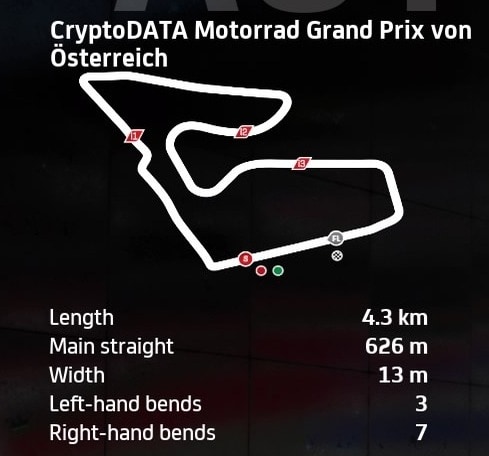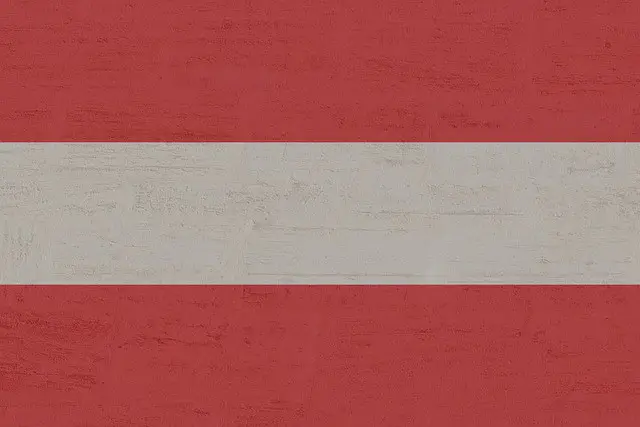The Red Bull Ring in Austria has been on the MotoGP calendar since 2016, with a revised layout from 2022 with a chicane breaking up the second straight. It’s one of the easier tracks to learn for sure with a straightforward sequences of corners, but still some tricky elevation change to pay attention to.

Thankfully, with the improved braking physics of MotoGP 23 from it’s predecessor, this track is much easier than on ’22, and as long as you’ve got a bike that’s stable under braking, you should be fine round here.
Doing a bit of testing, I was able to find a setup that felt food and stable to ride and lap consistently with.
Here’s a setup for MotoGP bikes for Austria on MotoGP 23:
- Suspension (Front Fork):
-
- Front pre-load – 5
- Oil Quantity – 1
- Front Spring Hardness – 5
- Front Swingarm compression – 1
- Front Swingarm extension – 4
-
- Rear Single Shock Absorber:
-
- Rear Pre-load – 5
- Swingarm connector – 3
- Rear spring hardness – 4
- Single shock absorber compression – 5
- Single shock absorber extension – 4
-
- Vehicle Geometry:
-
- Steering head inclination – 3
- Trail – 4
- Steering plate position – 3
- Rear swingarm length – 6
-
- Transmission:
-
- Gears (1-6) – 5-5-5-5-4-3
- Final ratio – 5
- Slipper clutch – 7
-
- Brakes:
-
- Front disc – 355 mm
- Rear disc – 220mm
-
- ECU
-
- Traction control – 5
- Engine braking – 5
- Anti-wheelie – 4
- Power mapping – 2
-
This setup wasn’t the outright fastest one I tested in terms of potential lap time, but it was the most stable and easiest to control and ride consistently with. Which is what I usually focus on with these MotoGP games as while it might be possible to set one very fast lap, it’s much harder to lap consistently multiple times without falling off.
For the ECU settings, no assists players might want use something like 1542 or 2542 – I set the TC higher to get rid of the annoying understeer in the handling model on ’23.
Alternative Austria MotoGP Class Bike Setup
I did test another setup, which is a very slight mod of my template/baseline setup I usually start out testing with.
Here is an alternate bike setup for the MotoGP class for Austria:
- Suspension (Front Fork):
-
- Front pre-load – 2
- Oil Quantity – 3
- Front Spring Hardness – 4
- Front Swingarm compression – 3
- Front Swingarm extension – 3
-
- Rear Single Shock Absorber:
-
- Rear Pre-load – 4
- Swingarm connector – 3
- Rear spring hardness – 2
- Single shock absorber compression – 3
- Single shock absorber extension – 3
-
- Vehicle Geometry:
-
- Steering head inclination – 4
- Trail – 4
- Steering plate position – 3
- Rear swingarm length – 5
-
- Transmission:
-
- Gears (1-6) – 5-5-5-5-4-3
- Final ratio – 3
- Slipper clutch – 3
-
- Brakes:
-
- Front disc – 355 mm
- Rear disc – 220mm
-
- ECU
-
- Traction control – 5
- Engine braking – 4
- Anti-wheelie – 5
- Power mapping – 2
-
Whilst I could have set some potentially faster lap times with this setup versus the first one, it didn’t feel as stable or easy to control so I’ll personally be using the top one as I always prioritize consistency over outright single lap pace with these setups on these challenging games.
But setups and bike handling are subjective to each player, so test out both setups to see what gives you the best results.
Austria Setup For Moto2 and Moto3 Class Bikes
For the less powerful Moto2 and Moto3 bikes, Austria is a great beginner’s track to ride. If you’re looking for custom setups for these classes, we have a generic setups page for MotoGP 23 with starter setups for Moto2 and Moto3 bikes that you can bolt on and test against the game default setup.
Tips For Riding Round Austria
The Red Bull Ring isn’t too hard of a track to learn in terms of knowing what’s coming next, but some of the corners still need some attention. Here’s a few tips for riding here.
Turn 1 – Braking point is later this year, past the overhead sign, when the kerbing starts on your left. Brake hard in a straight line taking multiple dabs on the front brake and you can use some rear brake to lean the bike into the apex (but don’t touch the inside kerb).
Turn 2 – Braking point is when you reach the overhead sign or just before, but in sunny conditions it’s actually tricky because the sunlight shines on the track and obscures the corners. You kind of just have to learn by repetition when to turn in to the 2a/2b chicane.
Turn 3 – A little bit tricky as it’s uphill. Again brake in a straight line, and I prefer a wide entry to get good acceleration onto the straight. You can use a dab of rear brake on it’s own to tuck the bike in, but be careful not the clip the inside kerb as it will often spit you off the bike.
Turn 4 – This is the corner after the last long straight. It was infuriatingly difficult on MotoGP 22, but is a lot easier on ’23. Brake hard with the front brake just before the track kinks slightly left, taking several stabs at it. Then you can dab the rear brake on it’s own to lean the bike into this sharp hairpin.
Turns 9/10 – Last 2 corners. Once you take the first one, it’s just a very slight dab on the power before you lift and lean into the last corner. You can dab the rear brake again to straighten the bike up coming onto the pit straight again.

